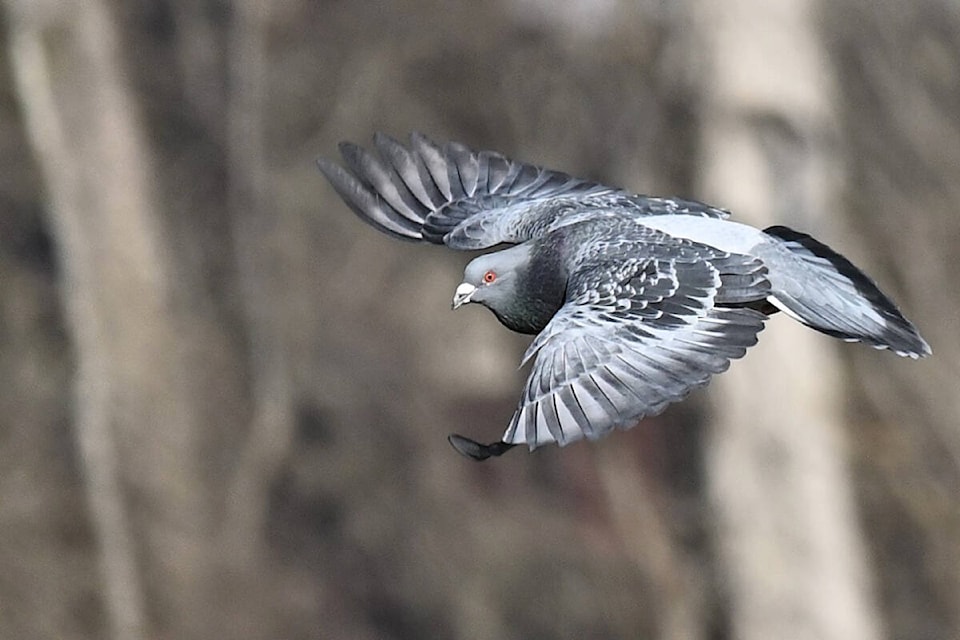Recently, as I sipped coffee in a downtown café, an otherwise cold and gray pre-Christmas afternoon came to life as a cluster of multicoloured pigeons rose into the air above Salmon Arm.
Circling squadron-style, they gracefully sailed back down to perch shoulder-to-shoulder on the telephone wires lining one side of the Trans-Canada Highway.
As chance would have it, about the same time a friend living in the Deep Creek area sent me a photograph of two peregrine falcons sitting in a dead tree near a cow-barn.
They were attracted there because of – you guessed it – the abundant pigeons feeding on spilled grain around the barns.
As one of the most seen birds in North America, I think pigeons have likely suffered from familiarity.
Since we seem to see them all the time, we don’t look at them any of the time.
The bird we call pigeon, is formally known as a rock pigeon. Their original homes were in Eurasia and North Africa where they continue to live as part of the native fauna.
Our rock pigeons were brought to North America about 400 years ago, likely as a food source for early settlers, but soon became feral. By feral, I mean an escaped domestic animal that has gone wild that now lives as a self-perpetuating population.
In their native habitat, these pigeons nested on cliffs and in rocky craigs, hence their name “rock” pigeon.
In their new-found North American homes, the brick buildings, cement silos and bridgeworks built by people served as stand-ins for their Old-World breeding habitats.
The food provided by agricultural spillage and refuse dumps around human settlements and along railway lines has produced the abundance of pigeons that live with us today. I think the first time I truly started to watch pigeons for their own merit was a winter afternoon four years ago when I was exploring the Shuswap River near the Mara Community Hall.
This valley bottom area is highly agricultural and as I crossed the bridge a flock of Rock Pigeons made a sortie out over the Shuswap River.
Since the lighting was perfect for photography, I nestled into one corner of the bridge with camera at the ready. Several hundred pictures later,
I had a collection of photographs that allowed me to study the pigeons in their natural element – the air – and I’ve been a rock pigeon fancier ever since.
Read more: VIEWPOINT: Steller’s jays brighten the days in the Shuswap
Read more: Column: A perilous time for grebes nesting in Salmon Arm Bay
Another newcomer in the pigeon family, the Eurasian collared-dove, has recently taken North America by storm and is now a familiar bird in backyards and farmlands across the Shuswap. Their history in North America started in the 1970s when a small group escaped captivity in the Bahamas. By the early 1980s, a feral population of Collared-Doves had crossed North America and became a common sight in the Columbia-Shuswap.
Now, I see or hear one of these doves nearly everyday of the year in town. Their call is a distinctive series of owl-like “hoo-HOOOO-hoos” heard throughout the day, especially in the spring.
I also hear them often in soundtracks of movies made in Europe or Asia! As their name describes, they black collars around the back of their necks.
Our list of Shuswap birds also includes two other species in the dove and pigeon family – the mourning dove and the band-tailed pigeon. These birds are both native to North America, but in my experience, not nearly as frequently observed in the Shuswap as the two from Europe.
Mourning doves are much smaller and make a distinctive mournful-like call.
Band-tailed pigeons are mostly birds of the Coast but they had a brief (and unexplained) period of abundance across the Interior of British Columbia in the 1970s.
Tracking changes in numbers and distribution of birds is the chief goal of annual Christmas Bird Count set to take place this year on Dec.17 in an around Salmon Arm.
This year I will be taking a close look at the results to see how many pigeons and doves are in the tally and how those numbers have changed across the years.
